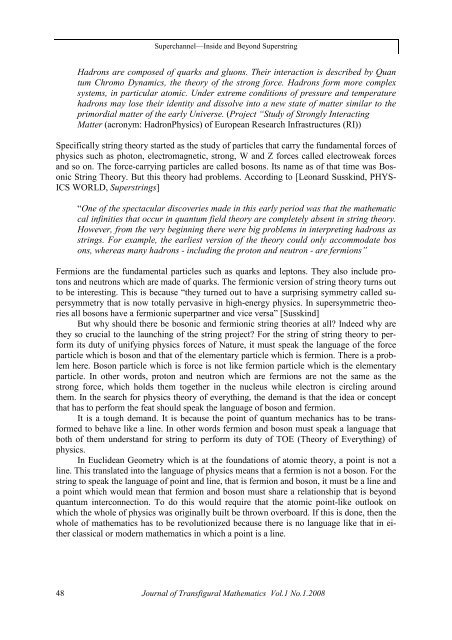JTfM Vol 1 No 1 2008 - ONLINE EDITION - Inclusionality Research
JTfM Vol 1 No 1 2008 - ONLINE EDITION - Inclusionality Research
JTfM Vol 1 No 1 2008 - ONLINE EDITION - Inclusionality Research
You also want an ePaper? Increase the reach of your titles
YUMPU automatically turns print PDFs into web optimized ePapers that Google loves.
Superchannel—Inside and Beyond Superstring<br />
Hadrons are composed of quarks and gluons. Their interaction is described by Quan<br />
tum Chromo Dynamics, the theory of the strong force. Hadrons form more complex<br />
systems, in particular atomic. Under extreme conditions of pressure and temperature<br />
hadrons may lose their identity and dissolve into a new state of matter similar to the<br />
primordial matter of the early Universe. (Project “Study of Strongly Interacting<br />
Matter (acronym: HadronPhysics) of European <strong>Research</strong> Infrastructures (RI))<br />
Specifically string theory started as the study of particles that carry the fundamental forces of<br />
physics such as photon, electromagnetic, strong, W and Z forces called electroweak forces<br />
and so on. The force-carrying particles are called bosons. Its name as of that time was Bosonic<br />
String Theory. But this theory had problems. According to [Leonard Susskind, PHYS-<br />
ICS WORLD, Superstrings]<br />
“One of the spectacular discoveries made in this early period was that the mathematic<br />
cal infinities that occur in quantum field theory are completely absent in string theory.<br />
However, from the very beginning there were big problems in interpreting hadrons as<br />
strings. For example, the earliest version of the theory could only accommodate bos<br />
ons, whereas many hadrons - including the proton and neutron - are fermions”<br />
Fermions are the fundamental particles such as quarks and leptons. They also include protons<br />
and neutrons which are made of quarks. The fermionic version of string theory turns out<br />
to be interesting. This is because “they turned out to have a surprising symmetry called supersymmetry<br />
that is now totally pervasive in high-energy physics. In supersymmetric theories<br />
all bosons have a fermionic superpartner and vice versa” [Susskind]<br />
But why should there be bosonic and fermionic string theories at all? Indeed why are<br />
they so crucial to the launching of the string project? For the string of string theory to perform<br />
its duty of unifying physics forces of Nature, it must speak the language of the force<br />
particle which is boson and that of the elementary particle which is fermion. There is a problem<br />
here. Boson particle which is force is not like fermion particle which is the elementary<br />
particle. In other words, proton and neutron which are fermions are not the same as the<br />
strong force, which holds them together in the nucleus while electron is circling around<br />
them. In the search for physics theory of everything, the demand is that the idea or concept<br />
that has to perform the feat should speak the language of boson and fermion.<br />
It is a tough demand. It is because the point of quantum mechanics has to be transformed<br />
to behave like a line. In other words fermion and boson must speak a language that<br />
both of them understand for string to perform its duty of TOE (Theory of Everything) of<br />
physics.<br />
In Euclidean Geometry which is at the foundations of atomic theory, a point is not a<br />
line. This translated into the language of physics means that a fermion is not a boson. For the<br />
string to speak the language of point and line, that is fermion and boson, it must be a line and<br />
a point which would mean that fermion and boson must share a relationship that is beyond<br />
quantum interconnection. To do this would require that the atomic point-like outlook on<br />
which the whole of physics was originally built be thrown overboard. If this is done, then the<br />
whole of mathematics has to be revolutionized because there is no language like that in either<br />
classical or modern mathematics in which a point is a line.<br />
48<br />
Journal of Transfigural Mathematics <strong>Vol</strong>.1 <strong>No</strong>.1.<strong>2008</strong>




